There are multiple approaches to valuing bitcoin and they can differ from traditional, institutional asset class valuations. The reason is that bitcoin can be regarded as a currency, a commodity, or a monetary payment network — at the same time. Bitcoin has many different characteristics which is why many different valuation approaches can be applied.
From a pure investment point of view, bitcoin has been one of the best-performing “store-of-value” investments of the past 10+ years, outperforming traditional assets like U.S. equities or gold by a very wide margin.
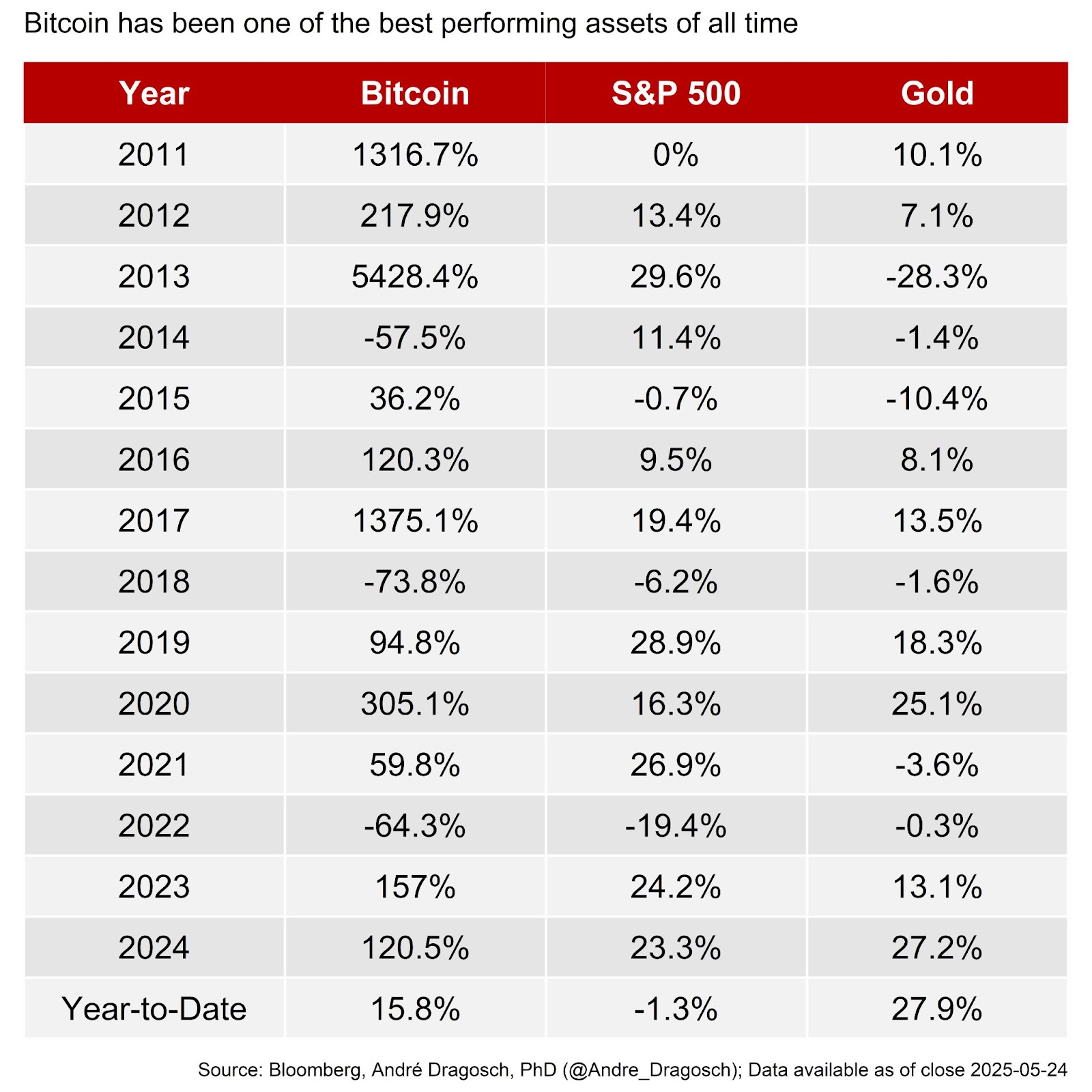
Why Adoption — Including Institutional Adoption — Will Increase Over Time
With respect to the adoption of bitcoin as a superior monetary technology, there are different segments of society that will be shaped in different ways. Think about the following:
- Individuals
Pervasive consumer price inflation has led to an erosion of purchasing power over the past decades, especially since the introduction of the fiat standard in 1971. Consumers have seen their purchasing power erode, particularly in housing.
As this erosion continues, individuals who adopt bitcoin as their primary store of value will see their purchasing power increase over time, especially relative to their social circle.
This will encourage others to copy this behavior to “keep up with the Joneses” (a Schelling Point in behavioral economics).
It is a focal point that individuals use to guide their decisions when trying to predict what others will do. Bitcoin will serve as that Schelling Point.
- Asset managers
It is widely known that only a small portfolio allocation to bitcoin can already have very significant effects on overall portfolio performance without a significant increase in portfolio volatility. In other words, a small bitcoin allocation can increase risk-adjusted returns of your portfolio, letting asset managers build more efficient portfolios.
In 2024, bitcoin was by far the best-performing major asset with a return of 121%, outperforming the S&P 500 but also the top hedge funds in the world.
In fact, bitcoin has been the best-performing major asset since 2011 in all years except 2014, 2018, and 2022.
The asset managers who added bitcoin to their multi-asset portfolio were able to outperform their peers both on an absolute and risk-adjusted basis. They will most likely win tomorrow’s Morningstar or Lipper Fund awards for outperforming their peers and exhibiting superior performance metrics.
Social and economic pressure exerted by clients and superiors will ultimately increase for those asset managers who don’t add bitcoin to their multi-asset portfolios.
In order to keep up with those who do, the only viable long-term solution will be to add bitcoin to their multi-asset portfolio, leading to increasing institutional adoption over time.
- Corporations
The economic motive to add bitcoin to corporate balance sheets is similar to that of individuals: to guard the corporate cash balances against erosions of purchasing power over time, which is suboptimal for its shareholders.
Moreover, corporations will be incentivized economically to add bitcoin to their balance sheet, because those who have outperformed their peers by a very wide margin.
Take Metaplanet in Japan, for example.
Metaplanet and its CEO Simon Gerovich were relatively unknown in Japan at the start of 2024. With a market capitalization of just JPY 1.95 billion (USD 14.5 million) at the start of 2024, Metaplanet was in the bottom 500 Japanese companies on the Topix, which tracks around 2,000 companies listed on the Tokyo Stock Exchange.
Metaplanet, normally engaged in diversified businesses such as finance, trading and real estate, publicly announced in early April 2024 that it would adopt a bitcoin standard and acquire BTC as the core asset of its treasury, committing an initial investment of 1 billion JPY (approximately 6.5 million USD).
This strategic move was inspired by MicroStrategy’s approach to bitcoin adoption. The company completed its first bitcoin purchase on April 22, 2024, acquiring 97.85 BTC for 1 billion JPY.
By the end of October 2024, Metaplanet had become the largest corporate bitcoin holder in Asia, surpassing competitors such as Nexon and Meitu.
As a result, its share price outperformed every single stock in the Topix and MSCI World in 2024, boasting a whopping +2,629% return.
Metaplanet is now among the top-5 largest corporate bitcoin holders in the world, with over 16,000 BTC on its balance sheet, according to the latest data from bitcointreasuries.net.
Metaplanet’s move is emblematic of the growing global appetite for bitcoin as part of corporate treasury strategy.
What is more is that it has very significant implications for other companies:
It is only a matter of time before not adopting bitcoin could result in a significant disadvantage for shareholders, as companies that do adopt bitcoin continue to outperform non-adopters by a wide margin.
As with asset managers, there will be increasing social and economic pressure on corporate boards and CEOs to adopt a bitcoin standard.
- Sovereigns
Sovereign adoption might have slightly different mechanics than private-sector adoption of bitcoin but the incentives are, mostly, of an economic nature as well.
El Salvador declared bitcoin legal tender in September 2021 and officially adopted a bitcoin standard. It was the very first country in the world to announce such a move. Since then, the country’s treasury has been acquiring more than 6,000 BTC.
As a result, El Salvador’s credit rating has significantly improved from a composite issuer rating of CCC+ in July 2021 to B- according to data provided by Bloomberg.
The improvement in credit rating was also due to a significant improvement in tourist arrivals and overall acceleration in GDP growth, which were also direct consequences of the move to adopt a bitcoin standard: It both fuelled domestic “animal spirits” and attracted more international visitors.
Nonetheless, this example goes a long way in demonstrating the economic benefits, direct and indirect, of adopting a bitcoin standard for nation-states.
In fact, El Salvador’s 1-year sovereign default probability declined significantly from a high of around 20% in April 2021 to slightly below 5% in March 2025, according to data provided by Bloomberg.
The decline in sovereign default probabilities is also generally beneficial for the country’s exchange rate since there is an inverse relationship between sovereign credit default swaps and exchange rates, especially in emerging market countries.
To sum up, other sovereign nations will likely be incentivized to adopt bitcoin because of the following reasons:
- Bolstering international FX reserves
- Improvement in fiscal debt situation
- Decline in sovereign debt default probabilities
- Improvement in credit ratings
- Decline in sovereign yields = improvement in financial conditions
- FX Stabilization = decline in import price inflation
- Indirect: increase in “animal spirits” and domestic GDP growth
- Long term: improvement in Net International Investment Position (IIP)
Social dynamics of Bitcoin adoption
There are several behavioral phenomena that could accelerate the adoption of bitcoin: network effects, the Lindy effect, and the Dunning-Kruger effect.
Network Effects
Network effects describe the phenomenon in economics where the usefulness or value that a user gains from a product or service increases with the number of other users utilising similar goods or services. This effect, also referred to as network externality or demand-side economies of scale, usually results in a product becoming more valuable as more people join its network.
There are two kinds of network effects: direct and indirect. Direct network effects occur when the adoption of a product by a large number of users makes the product more valuable to each user. This is different from benefits derived from price reductions due to increased adoption. Examples of platforms exhibiting direct network effects include social media sites like Twitter and Facebook, as well as services like Airbnb, Uber and LinkedIn, along with telecommunication tools such as telephones and instant messaging services.
Indirect (or cross-group) network effects arise when there are at least two distinct groups of customers that are interdependent, and the utility for at least one group increases as the other group(s) grow. An example of this is the increased value of hardware to consumers with the availability of more compatible software.
Thus, the spread of technology can be significantly influenced by network effects, making adoption self-reinforcing.
- In the context of bitcoin, the network effect implies that, as the Bitcoin network grows larger, adoption could accelerate as the size of the network could reinforce further adoption due to the higher utility that comes from using the network.
- Bitcoin’s network effects were firstly discussed in more theoretical manner by Trace Mayer in June 2015 as he outlined seven types of network effects that occur in the bitcoin ecosystem: 1) speculation, 2) merchant adoption, 3) consumer adoption, 4) security, 5) developer mindshare, 6) financialization and 7) adoption as a world reserve currency.
The Lindy Effect
The Lindy effect suggests that the future life expectancy of nonperishable entities, like ideas or technologies, is directly proportional to their current age. This means that the longer something has been around, the longer it is likely to continue existing. Longevity suggests a lower likelihood of becoming obsolete or being replaced. Originating from observations made at Lindy’s Delicatessen in New York by comedians, the concept has been further explored by mathematicians and statisticians.
This effect does not apply to perishable entities, like humans, whose life expectancy does not increase with age. The Lindy effect is relevant to items without an inherent expiration date, indicating that the probability of a technology being adopted increases with its age.
- In the context of Bitcoin, the Lindy effect implies that the likelihood that bitcoin will prevail increases with every day the network has been running successfully.
The Dunning-Kruger Effect
The Dunning-Kruger effect refers to the phenomenon where individuals with limited knowledge or skill in a particular area overestimate their competence. This cognitive bias demonstrates a systematic pattern of incorrect thinking or judgment. Biases are pervasive across various scenarios, and tendencies highlight specific patterns of thought or behavior observed among groups of individuals, although not necessarily manifested in every action.
In the context of technology adoption, the Dunning-Kruger effect can initially slow down the adoption process as people might underestimate the capabilities of new technologies and deem them irrelevant. However, as individuals invest time in understanding the technology, this effect can eventually lead to an accelerated adoption rate.
- In the context of Bitcoin, the Dunning-Kruger effect implies that, at the beginning of the adoption cycle, a high amount of (low-quality) critique and general aversion will be more likely than at the end of the adoption cycle. A high amount of unfounded critique should be viewed as an indication of an early stage of the cycle.
Quantitative model of Bitcoin adoption
“People are impinging on other people and adapting to other people. What people do affects what other people do.” – Thomas Schelling
Some researchers have noticed that bitcoin’s price performance has been following a power law very closely in the past.
Power laws are particularly useful in explaining phenomena in which minor occurrences occur frequently but major ones are uncommon. Here are some common examples where power laws can be observed:
Cities
A power law can be used to characterize the distribution of city sizes when analyzing the link between populations and cities. For example, the number of small towns and villages is far higher than that of large cities (let alone megacities like Tokyo and New York). Nonetheless, a disproportionately large share of the population lives in these big cities. Here, the power law suggests that, according to a particular mathematical relationship, the frequency of cities declines as their size grows.
Large Corporations
A power law can also be used to describe how different business sizes are distributed inside organizations. There are far more small and medium-sized businesses (SMEs) than there are major, global organizations with revenues greater than the GDPs of some nations. A power law distribution is compatible with the size distribution of these firms, which tends to be composed of many smaller companies and fewer large ones based on factors like market capitalization, number of employees or revenue.
Viruses
Power rules can be used to explain how viruses mutate or how epidemics spread. The theory is that while the majority of changes may not have much of an effect, a small number might drastically change the behavior of the virus — making it more virulent or transmissible, for example. A power law can also be used to describe the distribution of outbreak sizes, with most outbreaks being tiny, localized episodes, but a small number having the potential to expand into broad pandemics that impact millions of people.
There has indeed been some research that implies that the adoption of bitcoin as a monetary technology was spreading “like a virus.”
In general, the propagation of a virus tends to follow a power law dependent on time passed since the first infection.
In fact, a closer look at the price evolution of bitcoin reveals that the log of price has been increasing linearly with the log of time as expressed in terms of days since the Genesis block (January 3, 2009).
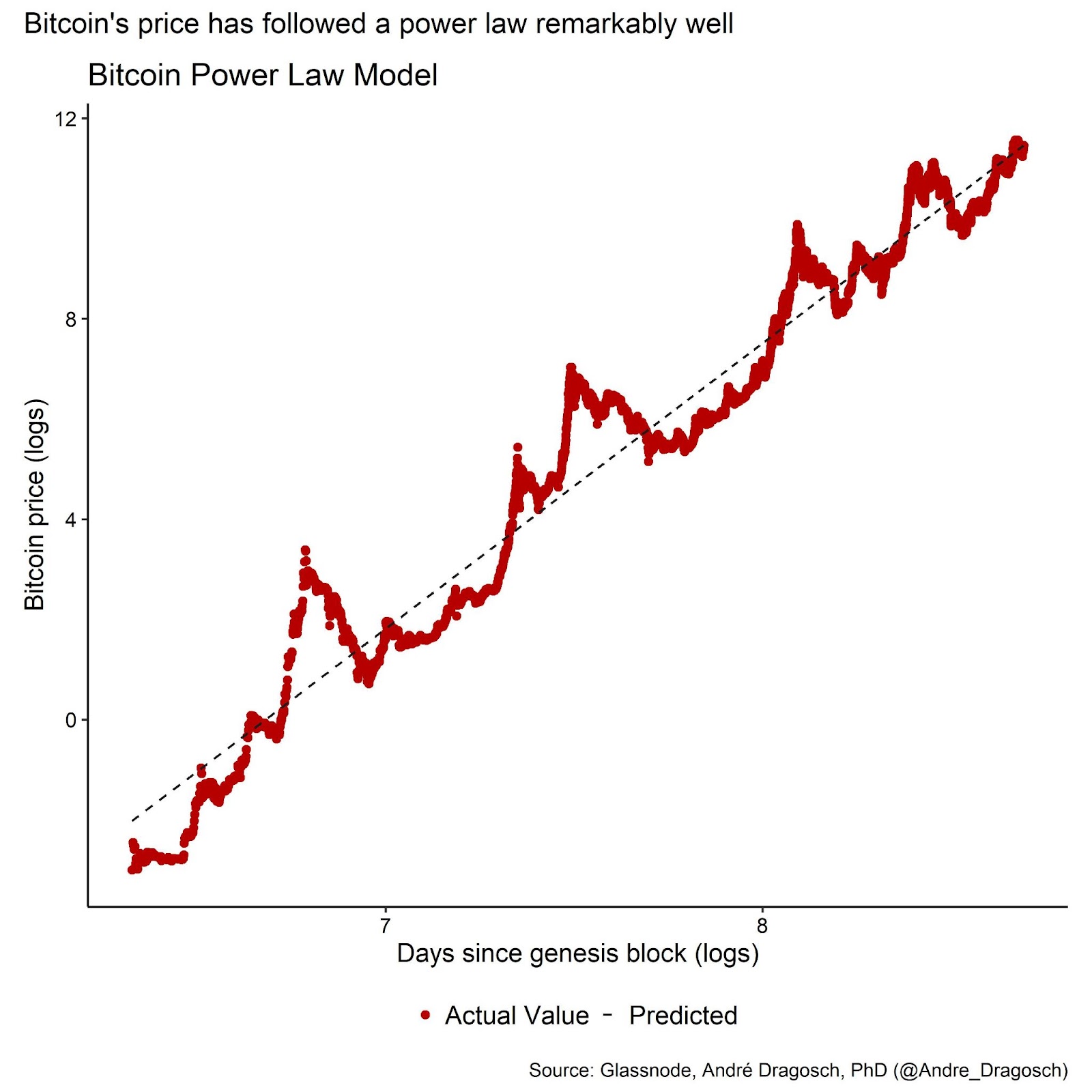
What is more is that both the number of active addresses/users as well as the hashrate of the Bitcoin network also adhere to this power law as shown in the following charts:
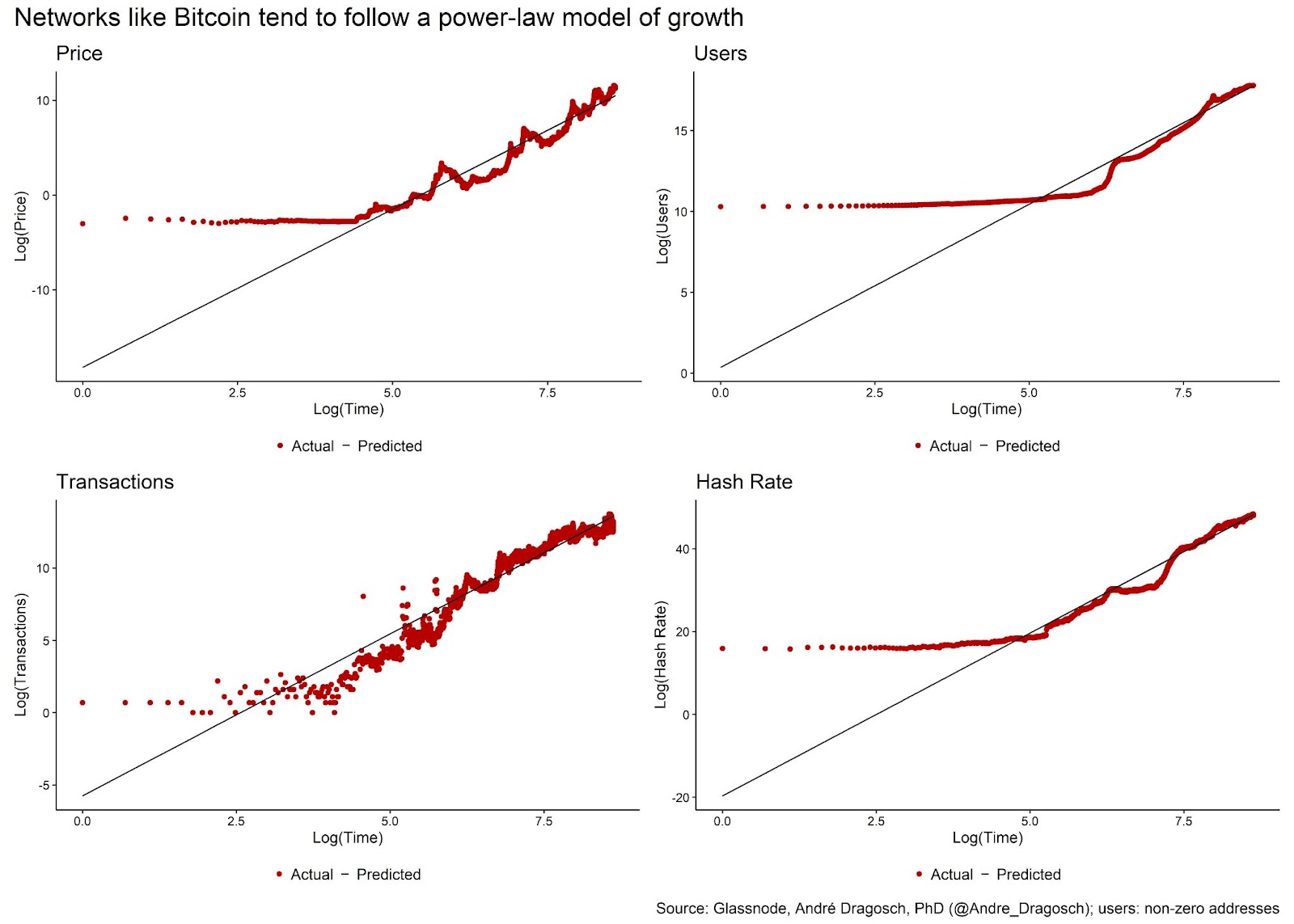
If we assume that bitcoin adoption would continue to follow such a power law in the future, the next chart suggests that the price could reach $1 million per bitcoin over the next 10 years.
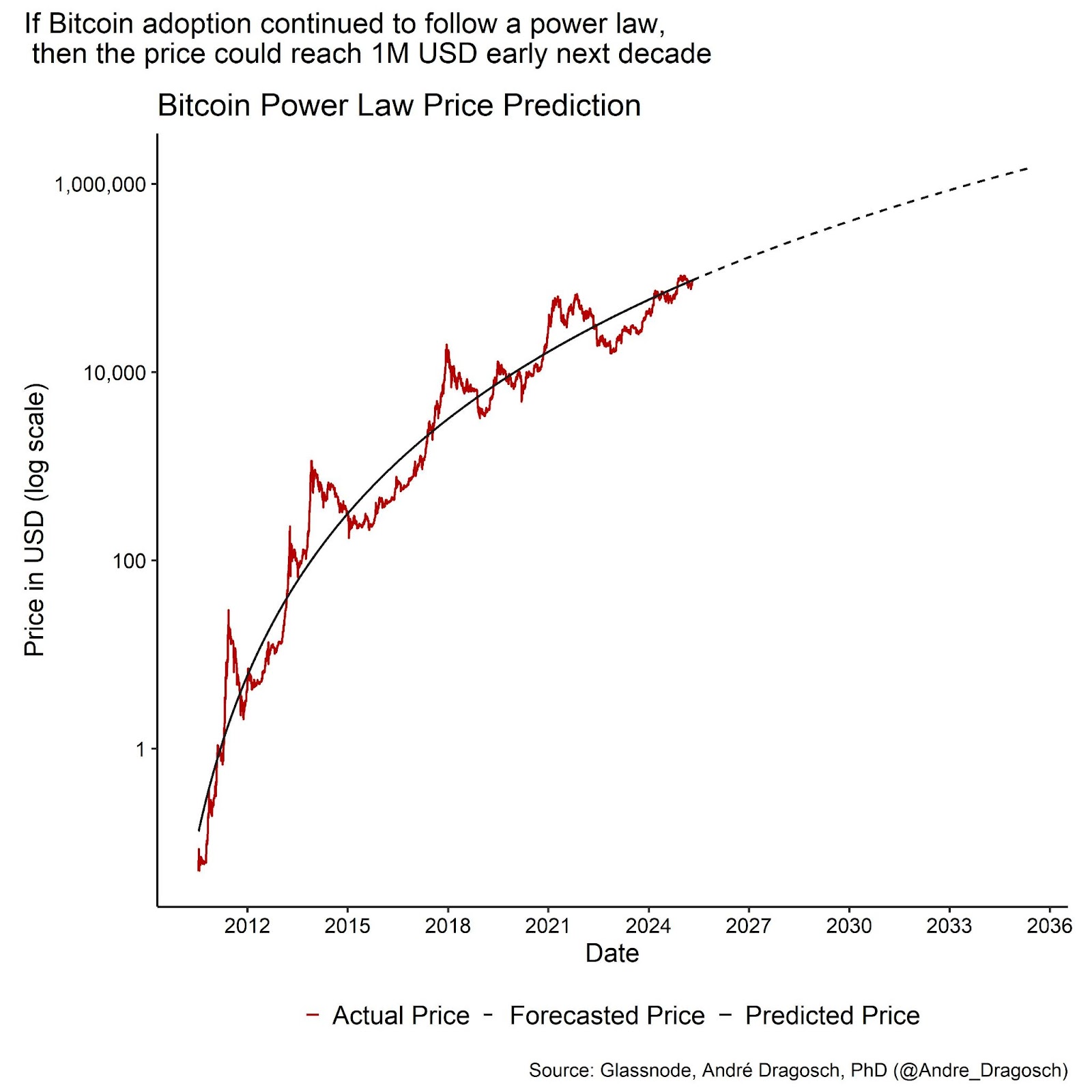
The implication of bitcoin following a power law is also that returns will decline marginally over time with increased adoption; ultimately, the adoption is “saturated.”
On a positive note, this also implies that risk/volatility will tend to decline over the long term.
Increasing Institutional Adoption and the Fractal Market Hypothesis: A Case for Lower Volatility
With increasing adoption, it is quite likely that bitcoin’s risk and volatility will also decline structurally over time.
The reason is that as market participants become more heterogeneous over time, increasing dissent among buyers and sellers is bound to have a stabilizing effect on market prices and volatility.
Imagine a high-frequency trader who might sell a position on account of a short-term trading signal. In contrast, a longer-term buy-and-hold pension fund might see a short-term decline in price as a longer-term buying opportunity; heterogeneity among investors has stabilized the price.
In contrast, market instability usually occurs in environments with increasing consensus and homogeneity among investors, e.g., many investors selling at the same time on account of the same kind of information can create price gaps/spikes.
This is also the logic of the so-called Fractal Market Hypothesis (FMH) put forth by Edgar Peters, often considered an antithesis to the dominant Efficient Market Hypothesis. The FMH assumes investors to be heterogeneous, to have imperfect information and also different investment horizons.
With respect to bitcoin, increasing heterogeneity through wider adoption also implies structurally lower volatility over time.
The following chart shows bitcoin’s price performance (upper panel) and its realized volatility (lower panel) over time. The horizontal lines represent the dates of the Bitcoin Halvings.

As one can see, bitcoin’s volatility has been decreasing structurally with every Halving.
Moreover, not only has volatility decreased but also the occurrence of extreme returns, both negative and positive, has declined significantly with every Halving. In statistician’s parlance: The return distribution has become less leptokurtic. This is shown in the following chart (each panel represents a single bitcoin epoch):
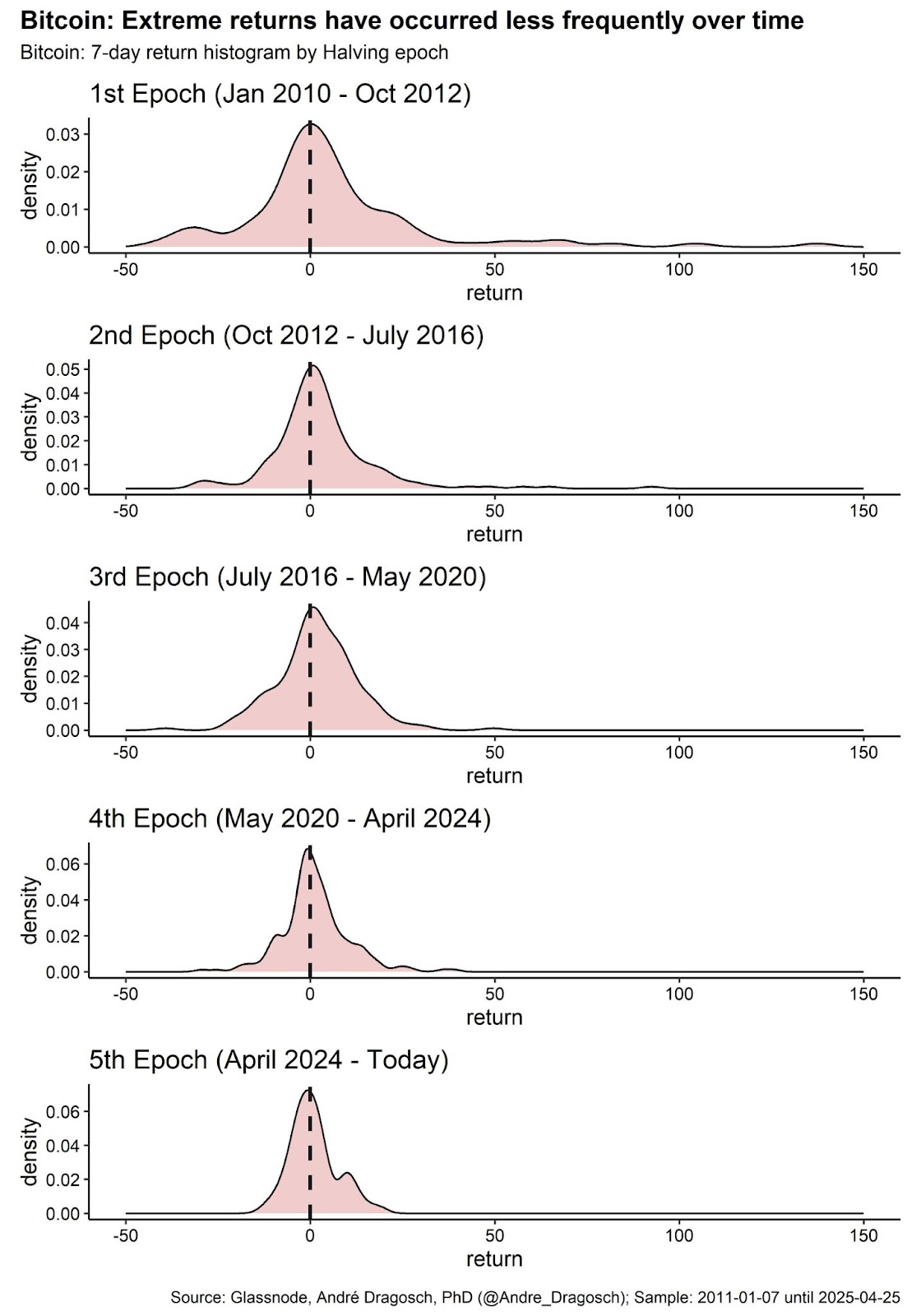
Bitcoin Halvings, which were usually followed by significant price appreciation in the past, can also be a significant driver of adoption itself as adoption usually lags increases in price.
The positive investment implication is that the risk characteristics of bitcoin will continue to change over time.
As adoption rises, bitcoin will likely evolve from a risky asset with high volatility to a safe-haven asset with low volatility.
The effect of those Halvings on bitcoin’s price performance will be analyzed in the following chapter.
Who Owns All the Bitcoin?
As far as a detailed breakdown of the holders is concerned, although the Bitcoin blockchain is highly transparent, the semi-anonymous nature does not allow for a direct identification of holders.
Furthermore, the analysis of holders is complicated by the fact that
- a single entity can control multiple wallet addresses (e.g., large single holders)
- multiple entities can be behind a single wallet address (e.g., exchange wallets)
Nonetheless, some companies have specialized in so-called “address tagging” and have created a separate database of identified bitcoin wallet addresses.
Besides, professional on-chain data providers like Glassnode provide aggregations of data, e.g., for the number of bitcoins held/controlled by exchanges, miners or ETPs.
There are also other databases such as the one maintained on bitcointreasuries.net which have compiled bitcoin holdings of corporations, governments, ETPs and other entities based on community entries and publicly available information. Although these data are generally incomplete and should be taken with a grain of salt, they provide the best overview of approximate bitcoin holdings of the different groups.
According to the latest data, most of the bitcoin supply still remains unidentified. The assumption is that these unidentified holdings are mostly controlled by individuals (52.4%).
The second-largest group of holders are exchanges like Coinbase or Binance who control around 15.1% of the supply of bitcoin. But behind these holdings are millions of individuals (and businesses) who are the ultimate owners of those bitcoin. A growing group of holders in recent years have been funds and ETPs as well as public companies (6.8% and 4.0%, respectively).
The so-called “Patoshi” holdings refer to the bitcoin holdings in wallets controlled by the creator of Bitcoin — Satoshi Nakamoto. Nakamoto’s bitcoin originally came from early mining efforts, which is why these holdings are often aggregated with overall miner holdings. They still represent a large part of the existing bitcoin supply (5.5%) but experts generally assume these holdings to be lost since they have never been moved. Probably lost coins (1.8%) are also those bitcoin holdings that have generally been idle for more than 10 years.
Although governments are still among the smallest group of bitcoin holders (2.7%), it is widely expected that government entities, including central banks and sovereign wealth funds, will increase their relative share of bitcoin’s supply over the coming years, led by efforts by the U.S. government and others to establish strategic bitcoin reserves.
News source: Bitcoin And The Next Adoption Wave
Read the full article and more directly from the source!
Enjoying our initiative? Support us with a BTC donation:
BTC Wallet: bc1q0faa2d4j9ezn29uuf7c57znsm5ueqwwfqw9gde


